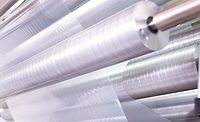Strategic Solutions
Adhesive Challenges for 21st Century Packaging
Adhesives manufacturers need to develop technologies to allow for the responsible reuse of packaging materials.

Figure 1. Growth drivers for modern packaging structures.1

Figure 2. Processing path for recycling of laminated materials.2


In ancient times, precious goods were kept in clay jars to protect them from the ravages of humidity and rot. Centuries later, barrels were invented to store water, grain and salted meats. By the Renaissance, glass packaging became available, which further improved shelf life and presentation.
The advent of the tin can—with lead-soldered seams, no less—enabled Napoleon’s armies to conquer most of Europe. That same packaging enabled American settlers to tame the Midwest and turn it into a food empire, sending packaged food to much of the world.
In the 20th century, metal and glass began to give way to flexible packaging—laminated polymeric materials that could work in many capacities where metal and glass were not necessary. Flexible polymer-based packaging became a way to reduce the “over packaging” of many goods.
Packaging has made the U.S. the most fed (some would say overfed) population on earth. Here, food insecurity is largely an issue of getting food to those in need based on economic or distribution issues. In underdeveloped countries, food insecurity results more from rot, spoilage or vermin infestation due to poor or nonexistent food packaging.
Packaging has improved the human condition for centuries. It provides safe food and pharmaceuticals, as well as clean beverages. But how much packaging is enough, and how do we reduce its environmental impact once it has served its purpose? The key issue for packaging in the 21st century is how to minimize its environmental impact once its job is done.
Adhesives in Modern Packaging
Adhesive technology is a key component of modern packaging, with technological advances driving future packaging trends. Our recent market study1 projected
3.5-4% annual growth in packaging through 2020. The graphics in Figure 1 give an indication of how complex and diverse modern packaging can be. Much of that packaging is sealed or laminated with adhesive, with paper and carton packaging largely sealed with tapes or hot melts. Laminated packaging may be produced with hot melts, other 100% solids systems, and low-VOC solvent or waterborne adhesives.
In some cases, packaging is too good. While it maintains freshness and safely preserves contents for long shelf life, there’s an increasing preference for smaller, individualized serving portions for “grab-and-go” consumption, according to the study. This results in smaller packages, but more of them. A significant amount of packaging represents content that is consumed within hours or days; then the packaging enters the waste or recycling stream. Ordinarily, most packaging of any kind is used within one week after sale, following weeks on a shelf.
Recycling is a major challenge for packaging. The recycling dilemma for most packaging materials is either how to recycle it profitably or how to generate cost-effective, meaningful repurposing. Figure 2 depicts a high-level scheme for plastics recycling.2 Many polymers are difficult to differentiate and to separate; this is further complicated when a laminating or closure adhesive system has been used.
Future Challenges
If we want to stimulate more recycling and repurposing, what are the challenges facing adhesive technologies? The overall goal is to “do good, not do less bad.” This means that new laminating and sealing adhesives must not only have good performance, but have more ability to be composted. Conversely, an adhesive may need to last longer if the package is designed to be reused, refilled and re-sterilized, or repurposed. Obviously, these are two ends of a longevity spectrum.
Ideally, fewer adhesives would be compatible with more film combinations to reduce inventory and to allow more composting or repurposing. The adhesive must be undetectable and cannot contribute odors, migrate, or be absorbed into contents. Nor should its performance properties be compromised by prolonged exposure to package contents. It may need to withstand common end-of-life reprocessing, including mechanical recycling methods involving washing steps, high heat, sorting and sanitation solutions, and even commercial enzymatic detergents. It must also work with new polymers or bio-based polymers that also have improved composting properties.
Packaging has always been used to make life better. The history of packaging has been one of materials substitution to provide maximum impact at minimum cost. Just as glass and metal have been recycled for centuries, in the 21st century, adhesives manufacturers will need to develop technologies to provide the safety, convenience, and responsible reuse of our packaging materials.
References
- “2017-2020 ASC North American Market Report for Adhesives and Sealants, with a Global Overview,” The ChemQuest Group Inc., 2017, https://www.ascouncil.org/store/ViewProduct.aspx?id=10934163.
- K. Kaiser, et al., “Recycling of Polymer-Based Multilayer Packaging: A Review,” Recycling, 2018, 3(1). www.mdpi.com/2313-4321/3/1/1.
Looking for a reprint of this article?
From high-res PDFs to custom plaques, order your copy today!








